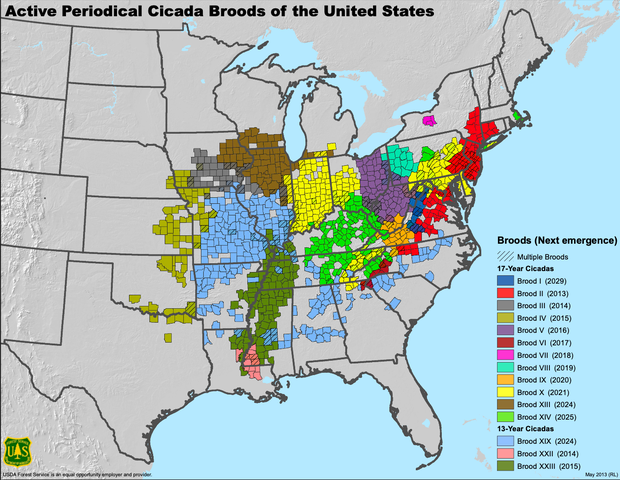▶ Watch Video: What to know about the trillions of cicadas about to swarm the U.S.
Trillions of periodical cicadas will emerge from the ground this spring, bringing with them their loud buzzing and molted exoskeletons. Here’s where you will be able to see cicadas in the U.S.
When are the cicadas coming in 2024?
There are two groups of periodical cicadas – those that emerge every 13 years and those that emerge every 17 years. For most of their lives, cicadas live underground and then emerge once the soil reaches 64 degrees.
Because they are temperature-dependent, their emergences may vary depending on the location. In 2024, they are expected sometime in May or early June, according to Ken Johnson, a horticulture educator at the University of Illinois.
Since it may warm up faster in southern states, such as South Carolina, the cicadas might emerge as soon as April, while in cooler states, such as those in the upper Midwest, they might not emerge until June.
This year, both the 13-year and the 17-year cicadas will emerge, arriving in numbers that have not been seen in generations.
They mate, molt and then die, leaving behind their offspring to bury themselves into the soil and lay dormant until their brood’s next cycle. They only last about a month above ground, and no, they aren’t dangerous. Unlike locusts, which eat plants, cicadas get their nutrients from small branches. Most trees, however, will remain unharmed.
Still, Johnson advises not planting any new trees ahead of a periodical cicada emergence. You can put netting around small trees and shrubs to keep them away, making sure openings are no larger than 1/4 of an inch so the bugs can’t get in.
Where will cicadas be in 2024?
The 13-year cicadas, called Brood XIX, will emerge in Georgia and the Southeast. The 17-year cicadas, called Brood XIII, will appear in Illinois. This will be the first time since 1803 that two broods emerged at the same time. The next time this happens will be 2037.
The overlap of these two broods has been dubbed by an expert as “cicada-geddon” – but it won’t be the biggest cicada event. In 2076, the two largest broods –XIX and XIV – will come out together. “That is the cicada-palooza,” University of Connecticut cicada expert John Cooley said.
The broods will emerge peacefully, but Cooley said hundreds of trillions – or even quadrillions – of cicadas are expected. That’s an average of 1 million per acre over millions of acres.
Some of the cicadas, however, may have come in contact with a fungal pathogen called Massospora cicadina, which makes them hyper-sexual. The sexually transmitted fungal infection turns them into so-called “zombie cicadas,” with a chalky, white plug erupting out of their bodies and making their genitals fall off. Cicada expert Matthew Kasson says it’s not yet clear how the fungus impacts other wildlife, animals or humans.
“The cicada continues to participate in normal activities, like it would if it was healthy,” Kasson, an associate professor of Mycology and Forest Pathology at West Virginia University, told CBS News. “Like it tries to mate, it flies around, it walks on plants. Yet, a third of its body has been replaced by fungus. That’s really kind of bizarre.”
Maps show where in the U.S. to see cicadas
The dual cicada brood emergence will primarily be seen in parts of Illinois and Iowa, as well as parts of Kentucky, Missouri, Arkansas, Tennessee, Mississippi, Alabama, Georgia, South Carolina, North Carolina and Virginia.
A map from the U.S. Department of Agriculture shows the emergence of both the 13- and 17-year cicada broods from 2013 to 2029.





































